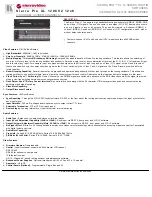
8
Configuring Quality of Service
Configuring Access Control Lists
Configuring Auto VoIP
Configuring Class of Service
Configuring Diffserv
This section gives an overview of
and explains the QoS features available from
the QoS navigation menu.
In a typical switch, each physical port consists of one or more queues for transmitting packets on the
attached network. Multiple queues per port are often provided to give preference to certain packets
over others based on user-defined criteria. When a packet is queued for transmission in a port, the rate
at which it is serviced depends on how the queue is configured and possibly the amount of traffic
present in the other queues of the port. If a delay is necessary, packets get held in the queue until the
scheduler authorizes the queue for transmission. As queues become full, packets have no place to be
held for transmission and get dropped by the switch.
QoS is a means of providing consistent, predictable data delivery by distinguishing between packets
that have strict timing requirements from those that are more tolerant of delay. Packets with strict
timing requirements are given “special treatment” in a QoS capable network. With this in mind, all
elements of the network must be QoS-capable. The presence of at least one node which is not QoS-
capable creates a deficiency in the network path and the performance of the entire packet flow is
compromised.
Configuring Access Control Lists
s ensure that only authorized users have access to specific resources while
blocking off any unwarranted attempts to reach network resources. ACLs are used to provide traffic
flow control, restrict contents of routing updates, decide which types of traffic are forwarded or
blocked, and above all provide security for the network. 200 Series software supports IPv4, IPv6, and
MAC ACLs. The total number of MAC and IP ACLs supported by 200 Series software is platform-
specific.
You first create an IPv4-based, IPv6-based, or MAC-based rule and assign a unique ACL ID. Then, you
define the rules, which can identify protocols, source and destination IP and MAC addresses, and other
packet-matching criteria. Finally, you use the ID number to assign the ACL to a port or to a VLAN
interface.
IP Access Control Lists
An IP
allows network managers to define classification actions and rules for specific ports. ACLs are
composed of
, or rules, that consist of the filters that determine traffic
classifications. The total number of rules that can be defined for each ACL is platform-specific. These
rules are matched sequentially against a packet. When a packet meets the match criteria of a rule, the
ExtremeSwitching 200 Series: Administration Guide
298
















































